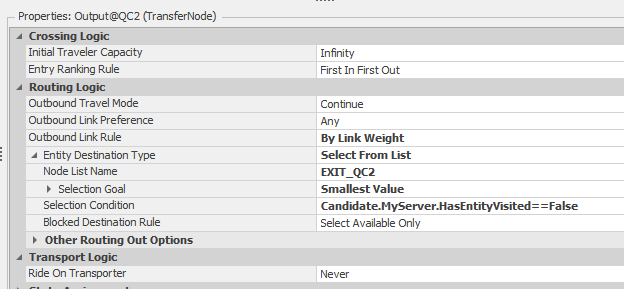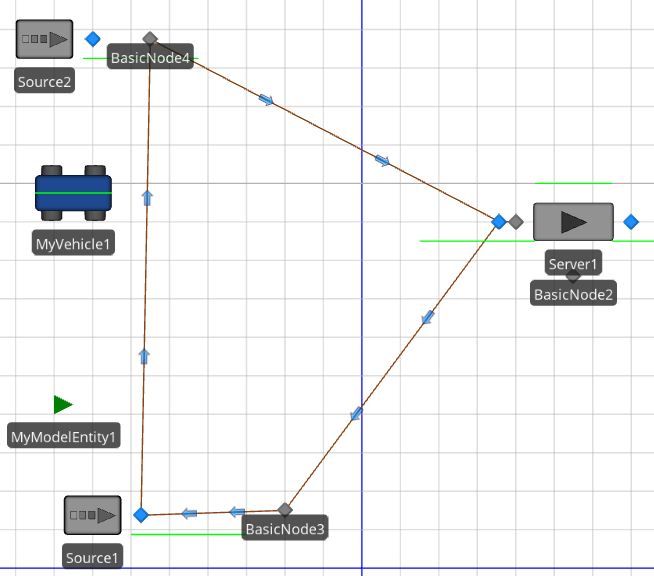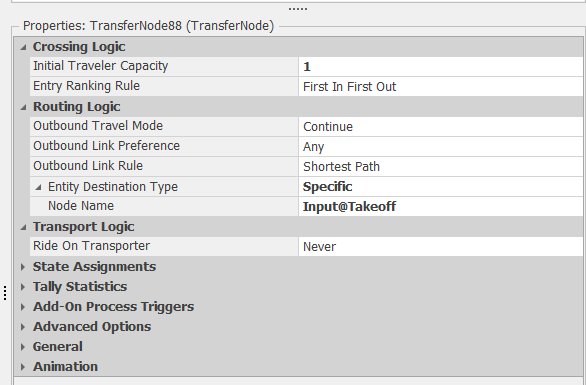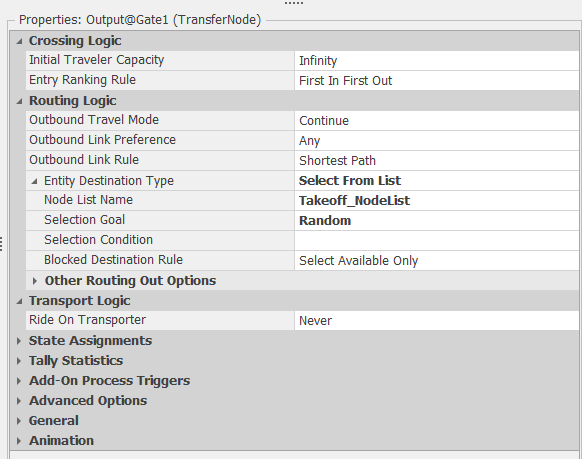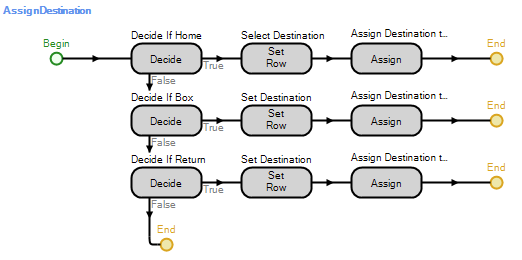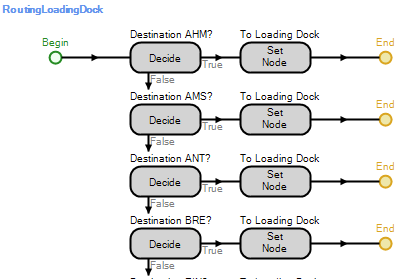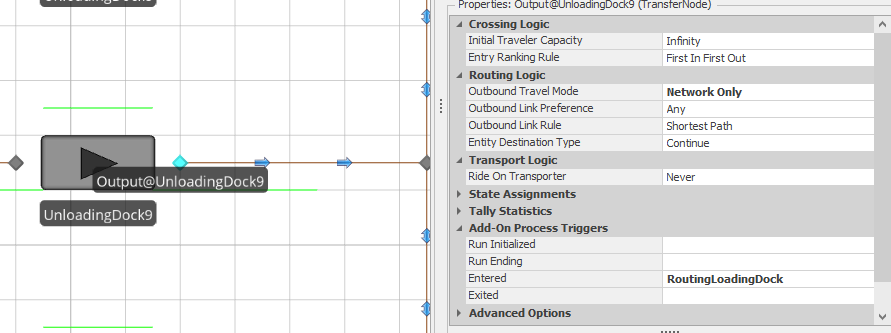Search the Community
Showing results for 'destination'.
-
I second this idea. If we can directly assign string name to a object-reference state variable, then use the object-ref state variable as the Object, it will be a lot helpful. String concat is a very good one, for example , ModelEntity go through NodeA, we define its next destination as NodeA_a ....
-
Thank you for the quick and detailed response! I see the error I was making with work schedule and have tested it on one server, it seems to work as intended. Since each of my servers have a different capacity, would I need to create a unique work week and unique day type for them all? Or is there a quicker work around? The manual inputs for the date time are a great work around, I'm only modeling for a few years so I don't mind inputting a few dates. What I mean by there being no buffers is that no server can have a queue. I used a list for selecting the destination on the output node of each source (total of 8 ) where it's a hierarchy. It can go to a select number of servers and if all of them are full it goes to a dummy server of infinite capacity that exits the items to an overflow sink.
- 2 replies
-
- server
- work schedules
-
(and 2 more)
Tagged with:
-
Hi, there is a simple approach you can use. Use Connectors between the queue server and the desks. At Buffer Logic of the Desks, change the Input Buffer Capacity to 0. Create a List with the Input nodes of the seven Desks. On the Output of the queue server change Entity Destination Type to Select From List and the goal to Smallest Value. Keep the default expression. It should work fine.
-
Hi everyone, I am trying to model entities moving from 10 origins (sources) to 10 destinations (sinks). The entities are simultaneously created according to a certain mix (Entity1 (85%), Entity2 (10%), and Entity3 (5%). However, the number of entities created per event is according to a certain distribution. There is an OD-matrix that captures the number of entities moving from origin to a specific destination. Let's say there are 10 destinations, than the destinations of the Entities are determined according to the OD-matrix: Entity1 and Entity2 can move to any of of the sinks. Entity3 can only move to one specific sink. One solution I came up with was to add weights to Connectors and assign destinations using TransferNodes, but I think that this is very inefficient. I then started to work with DataTables, but I cannot figure out how to probabilistically assign the destinations of the entities. My question is: how to model the probabilistic destination assignment of Entities using DataTables in such a way that it is relatively easy and flexible to add or remove Sources/Sinks? I have added the model for you to see, I hope that you can help me! Many thanks in advance Simple_OD_creation.spfx
-
Hi I've got a model where the situation is like this: 1. 3 Worker: W1 W2 W3 2. 3 Server: S1 S2 S3 On Monday (work schedule), W1 will work in S1 in the morning and work in S2 in the afternoon. W2 will work on S2 in the morning and S1 in the afternoon. But on Tuesday, W1 will work in S2 in the morning and S3 in the afternoon. W2 will work in S3 in the morning and S2 in the afternoon. The server properties in the secondary resource are "select from the node list." But since the node list for S1 and S2 contain both W1 and W2, and they both have the same hour of working (4+4), when the S1 server seized the resource on Tuesday morning, instead of W1, W2 got allocated instead( W2 should be in S3). I have tried: 1. Using server selection goal to " smallest distance," but it didn't work since the worker will keep swapping the room every day 2. Giving each worker a new initial value and setting the selection goal to "smallest value," but they still have the issue. 3. Try setting idle action for the worker to stay at the node, but sometimes the worker will go to the wrong destination from the first entity, hence no one working in the other room. (2 worker stay together) Is there any method to realize this idea? Thanks in advance
-
Referenced definition type and executing type error
Gashi replied to Gashi's topic in SI General Discussions
Thank you for the model! It took a long time to get the sprint release but now I can see it and it helps. Now I have another problem. I am trying to do a pick up at two different places and the drop off at one destination. There I want to have the transport costs split on the entity with the calculation TransportCostRate/TransportQty. The logic works like this: The transport from Source1 to Source2 (or BasicNode4) should be charged and assigned to ModelEntity.Cost. Then from Source2 to Server1 another calculation should be done, now with the increased transport quantity in dependency. But in BasicNode4 the process is not triggered by the ModelEntity, but by the Transporter. Is there any way that the process is triggered by the passenger? (the entity in the ridestation). The model is in the appendix. Best regards. Model_421.spfx -
Hello, I have two concerns. In one of my small models I want my transporter to make a round and pick up the entities at the different locations and bring them to a destination (Server1). In addition, I would like that the individual times are measured with a state MyModelEntity.TmpStart and MyModelEntity.Duration, in order to calculate afterwards with a transport cost rate the cost for each individual part. Unfortunately I'm getting desperate with this and getting various error messages, does anyone know how to implement this? Best Regards, Gashi
-
Hello River, I downloaded your files. The Gate512 was missing. I removed the information in the "30 Departure.xlxs" file that I can run the model ;-). Generally I understood how it works. Answer to your first question: I think you mean these two ways, right? From the left and from the right. In this case I saw that you used the "Routing Logic" in like all Transfernodes. The Outbound Link Rule is "Shortest Path" and you set the "Node Name" to "Input@Takeoff" Simio is using everytime the shortest link path now. Like in the screenshot below: In my opinion it would be better to set the destination once after the Entity got created in the Source for example :-). There are different ways to do that. In your model I removed all Routing Logic in the Transfernodes and used the Routing Logic only in the Output-TransferNodes of the Sources. In Simio you need only to use one time a SetNode-Step or a Routing-Logic to set the destination of an Entitiy and Simio will follow the paths or travel in the FreeSpace. You can use for example a NodeList with 2 different destinations and this Routing-Logic: With the "Selection Goal" Random Simio will randomly choose the destination from the NodeList. I uploaded you your model with the changes as an example: Problem on the taxiway version 17A.zip What did I changed? 1) I removed the Routing Logic in all TransferNodes. 2) I added new Routing Logic to the TransferNodes of the Output-Node of the Sources. 3) I added a NodeList with 2 new Nodes. 4) In the two new Nodes I used a Nodes-Entered-Process and a Transfer-Step to transfer the Entity to the Input of the Sink. Answer to your second question: You can change the destination of an Entity any time. In the Path (Link) you have a function called "NumberTravelors" for example to get the number of travelors currently on this path. So you can use a Expression like "Path123.NumberTravelors < 2". This can be used to decide if a way is full allready that the other way get selected. Or you can use a Integer-State and count up and down. I would use a Node-Entered-Process in the last possible node with a Decide-Step and two SetNode-Step in this case :-). I hope my answer will help you. When you have any other question, you are welcome! Best regards Pascal
-
Thank you Dave! Inspired by your approach, I defined two Node Reference State Variables for the Entity: EndDestination and NextNode. In the model Processes, I first determine the Entity State Variable EndDestination based on a DataTable with probabilities per destination node. Then, at routing decision points, I have created processes that evaluate the EndDestination node and set the next node for the unity based on that. Although it requires a bit of 'hard modeling', it works like a charm! Thanks
-
Hi David, I am trying to get your option 3 to work in my model, as the solutions sounds brilliant. I created an Add-On Process that probabilistically assigns destinations to the Entity and by assigning the destination node to the Entity's State Variable MyDest. In the Routing Logic, I've set the Initial Sequence to the sequence table called Routes that holds all possible routes. However, the entities now only follow the first sequence Routes (Input@LoadingDock9, Input@Sink_HTB), whereas Entities with the destination Input@Sink_RTM should follow the sequence Input@LoadingDock10, Input@Sink_RTM. How can I let the Entity follow a specific sequence from my Sequence Table Routes?
-
Hello every body. I am a beginner on SImio and this software is very powerfull. I have a problem I want to modify Fixed route vehicle's destination. I don't want a vehicle on demand.I need a fixed route vehicle. But I need to modify the vehicle's destination. Because I want the first vehicle Go to the first source and i want the second vehicle go to the second sources. And I have 80 vehicle and i want this loop destination for all vehicle. It's works very well for the First 5 vehicles ( For Source_Aub_Char in my model) and it's doesn't work for the sixth and after it's works. But my method doesn't work for all vehicle. I don't understand why. My method is : - I select the current vehicle with "Path1.Contents.FirstItem" - And After with "set Row" i selected différent sequences table for the current vehicle - I do a count for the number vehicle entrance and the model choice the good sequence table with this counter. There is my simplify model in attachement. Some body can help me to see what's wrong or to give me a better method ? Thank you very much. And sorry for my english i'm french. Question FOrum.spfx
-
Hello Gosia, I recommend using two State Variables to record the start and end times using the function TimeNow upon the Vehicle’s arrival to a Node. A Decide step is needed to check if the Current Node is different from the Destination Node and that is when values of the State Variables are assigned using the Assign step. The Processes will be set at the Vehicle’s Add-On Process Triggers On Entered Node and On Exiting Node. You can visit the SimBit section under the Support ribbon and check the SimBit titled “Record Distance Traveled” to see a similar example. Another approach is to create a custom Vehicle Class and use a Level State Variable instead of the two Real State Variables to collect information of the travel time. I suggest exploring the Level State Variable in the Help pages under the chapter titled “States”. I recommend checking the SimBit titled “Using Level States (from project Infection Propagation Using Continuous And Flow)” as well. Best Regards, Khaled
-
hello i'm the simio user in south korea i want to make my model flexibily. My model has vehicle and elevator The overall process flow is vehicle take entities to server1, After vehicle arrived to server1, elevator take entities and go to every destination. To work well, Three things are needed for this trend First, i want to do if the vehicle comes to server1 then the elevator goes to upstair Second, the vehecle has to wait until the elevator after been to upstair and arrive to server1 Third, repeat the two steps. how can i solve the problem this model in Model2, not Model1 1veh1eleModel.spfx
-
Hi, I have a series of shipping containers that are fed by a single conveyor, and I want all the containers to fill to a specific capacity whilst minimising the total time to fill. That means that if a container downstream is busy transfering-in an entity, then subsequent entities should stop at an upstream container to mitigate any queing, whilst respecting the capacity limits. At the moment I have the containers represented by sinks, but this doesn't allow me to set capacity limits. I'm using a TransferNode to set each entity's destination with a sequence table, but this doesn't reflect that an entity's destination might change enroute if it's desitation becomes busy or full as it transits. Can anyone please offer some advice or point me towards a SimBit that does something similar? Thanks, Craig
-
Hello All, I am new to Simio and trying out a simulation of an aircraft component assembly shop. I am using Sequence table for my jobs routing and processing scenarios which is - Source -> Set A (4 servers) -> Set B (7 servers) -> Set C (5 servers) -> Set D (2 servers) -> Sink Here each Set denotes similar workbenches to any of which a job can be routed based on utilization and availability at that point of time. So for routing job based on above criteria from Source, I created sequence table with 'Node list property' (which is list of input nodes on 4 servers of Set A) instead of 'SequenceDestination Property' as required by Sequence table. I want to replicate the sequencing from Source -> Set A -> Set B and so on. But want simio to pick the server of these sets based on my criterion. Unfortunately it is not working as I assume Sequence table need to have specific node as SequenceDestination. I am not sure if I am doing it right or what is correct and way to do it. I will highly appreciate any suggestions to make this happen in Simio. Thank you. -Mohmed
-
Hi, I have different type of entities queue up at an server output content waiting for a worker comes to pick them up for further process. After picking up, each entity will be sent to the corresponding location for further process. Ex: Product A goes to Server A, Product B goes to Server B ...etc. Can I pick up the entity based on the condition of capacity remaininig of the destination? Ex: Suppose we have 4 products A, B, A, C queue up. When the worker comes to pick up the first product A, he will check the capacity remainig of the destination Server A. If there is still capacity in the Server A, then go. If there is no capacity in the Server A, the worker go check the second product B and see if there is capacity in the Server B... etc. Can someone give me some idea how I can do this? Thanks for the help!
-
Hello I have a question about how to set up an Add-on process so that vehicle could drop off the entity based on the capacity of the conveyor, and if the capacity if full and the vehicle will be on idle.
-
Hello, I am modeling a container terminal. I have different servers which model my container storage yard. I have two different Model Entities, "ImportContainers" and "ExportContainers". I created an Add-On Process on Entering the OutputNode of the storage servers. In this process, the destination node is defined ("SetNode"-step) based on the type of Entity and a transporter ride is initiated ("Ride"-step). It works. Now I want to change the destination to a group of servers (which represent a group of truck loading stations). So I grouped the InputNodes of these servers into a NodeList. But in the Add-On Process I can't set the NodeList as a Destination in the "SetNode"-Step. I need this, because I want to set different NodeList's as a destination for my "ImportContainers" and "ExportContainers" respectively. My questions are: 1. How can I set a NodeList as a destination in an Add-On Process? 2. When using NodeList's as destination, how can I be sure that only servers are choosen randomly from that list which are not full? Thanks!
-
Hello, I am very new to Simio and still learning. I have 2 different entity types, Long and Short. I have a source which goes to any of 2 available workstations, no restrictions needed here. Those 2 workstations then need to send their processed entities (randomly Long or Short) to 2 other workstations, Saw A and Saw B. If the entity is Long, it absolutely must go to Saw A, if it is the Short entity, it must prioritize Saw B, but if Saw A is available and Saw B is in use, it should go to A. How can I do this? Thanks in advance. Samuel
-
Please excuse a naive question from a newbie. Building a simulation for material flows in selective mining. Entities, "low_grade" and "high_grade", supplied at different rates by two sources, both go into a server (the mining machine) which passes them to a separator. I want the high_grade entity to go to a processing subsystem, and the low_grade entity to go to backfill (or a waste dump). Do I presume correctly that I should use a Separator for this? If so, how do I set it up to send the two entity types to different destinations ? At present, all seem to be going to the same destination. Instead of having different entities, could I use one entity type and assign grade values according to a probability distribution? If so, how would I then use a separator to send below-cutoff material to backfill?
-
Dear all, I would like to know how to model the following problem: At creation, each entity gets a destination node. But 5 % of the entities have to make a stop-over at a certain node called "security check". After going through "security Check" the entity has to go to the destination he gained at creation. How to model such a "stop-over"? Thanks!
-
Figured this out using state variables and data tables used as the destination based on state of same row.
- 2 replies
-
- routing
- expressions
-
(and 2 more)
Tagged with:
-
I am trying to make a routing decision based on the Candidate node's routerequestqueue's summation of the entities user-defined property. If there are different types of entities with ex. different priority levels. I would like the routing process to choose the transfernode which has the smallest total sum of it's entities priority level. the transfernode that needs to be chosen also has a routing group attached to its entity destination type rule where its final machine has 0 buffer and due to a blocked destination rule, there will be a queue build up at the transfernode that needs to be chosen. I have thought about using a state variable for each node and using add-on process each time a unit enters and leaves a node but because the main model has many multiple nodes the node's entity priority sum has to be able to be accessed through the candidate.transfernode._________________. For example during the routing step in the process section, I have candidate.transfernode.destinationroutinggroupname.routerequestqueue which gives me the node's number of units waiting, but i need to be able to access the candidate nodes summed queued property. Is there either a way to directly access this information, have looked at the expressions and having a hard time finding something. failed attempt: candidate.transfernode.destinationroutinggroupname.routerequestqueue.population.defaultentity.priority.summation or is there a way to use the add-on process where i am adding/subtracting the priority levels, but somehow attach it to the candidate.transfernode's property Hopefully this makes sense. If you look at the file, please ignore the upper half and focus on the transfer nodes maintransfer, transfernode1 and transfernode1_1. maintransfer has an entered add-onprocess which is the subject of this question. the route process and it's selection expression is what I'm trying to adjust but find a way to express the candidate transfernodes of transfernode1 and transfernode1_1 (which are part of the XferRouting group). I'd like to choose and compare the total summed priority level of each node's queue. Simple_Routing.spfx
- 2 replies
-
- routing
- expressions
-
(and 2 more)
Tagged with:
-
A quick solution to force all entities to get dropped at the same place is to add an add-on-process when an entity is loaded. which Checks if the entity is the first item in the vehicle and if not set its destination node to the first item. Decide: Token.associatedobject==Token.ContextObject.Vehicle.RideStation.Contents.FirstItem If False -> SetNode: Token.ContextObject.Vehicle.RideStation.Contents.FirstItem.ModelEntity.destinationnode a more elegant solution would probably involve batching the entities into a bucket that would then get transported to the destination. Upload 11.1.21.spfx


